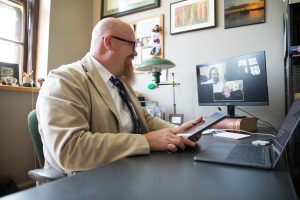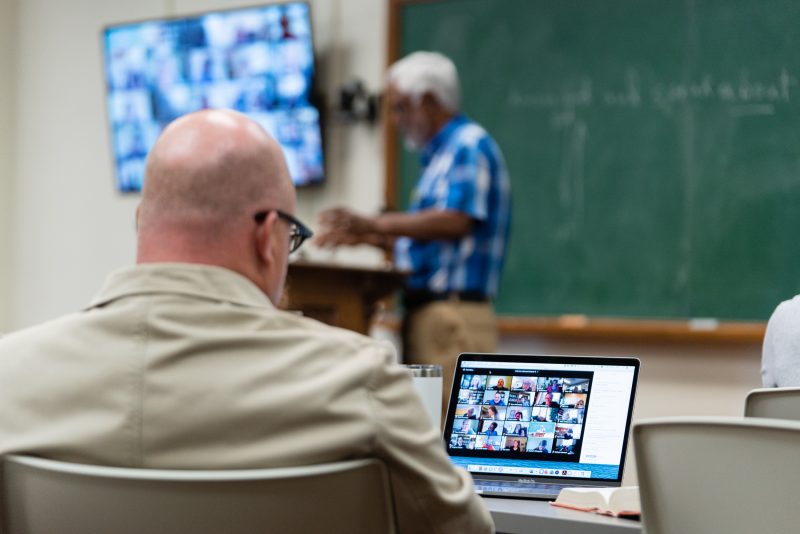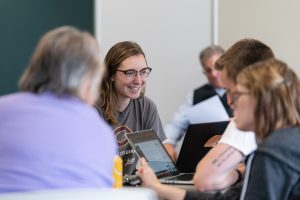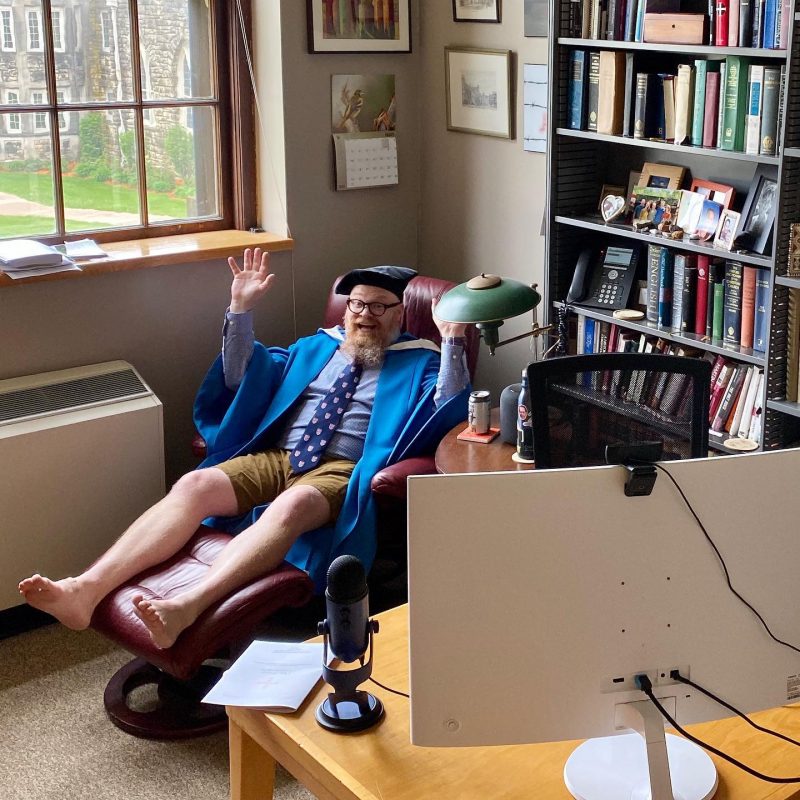
Midway through Lent, I was struck by how well-prepared our Wartburg Theological Seminary students and recent graduates are to tend to the unique impact of the flatten-the-curve social-distancing response to the “Rona” (a.k.a., COVID-19) pandemic—the shift of parish life from physical to digital space.
Literally overnight, people across the United States and around the globe were prohibited from gathering physically because of social-distancing measures. Out of care for the neighbor and trust that the Word can be a means of the Spirit with the internet serving as a semipermeable digital sanctuary, innovation happened. Boom! Overnight, sermons moved from proclamation shared with physical gatherings to digital proclamation shared via the likes of Zoom, Facebook Live, and YouTube. I have been and continue to be impressed with our students’ ability to hold together the technological innovations and faithfulness to the Gospel of Jesus Christ.
A common thread that I lean on when speaking to students about preaching and leading worship is to encourage planning, tending, and leading worship as if it matters for the life of the world. While we don’t make the Triune God present, we as leaders invoke and steward Christ’s presence in a way that embodies and communicates Christ’s promise to show up. The 20th chapter of John regularly comes to mind. Jesus showing up to Mary in the fog of grief and fear and bewilderment and cutting through the fog with the intimacy of her name. Jesus showing up to the disciples—not once, but twice—when they are huddled in fear and confusion behind locked doors. Jesus shows up, greets them with “Peace be with you,” and shows them by way of his wounds who he is—the crucified and risen Lord.
Lent has come and gone, and in the words of one of the many memes that have sprouted at the fertile intersection of pandemic and church: It was the Lentiest Lent ever! Even fully in the season of Easter, we continued to huddle behind locked doors. While fear motivates some, I’d like to think that many huddle for love of neighbor. Flatten-the-curve, after all, is an exercise of faith active in love, especially for those whose health is fragile, whose immune systems are compromised. It is an expression of love for healthcare workers, first responders, grocery store employees, truckers, delivery folks, gas station employees. So, we huddle. We practice social distancing.
The faithful use of technology has facilitated the Word passing into the locked rooms of our huddling. Our students and recent grads, along with many other tech-savvy (and some not-so-tech-savvy) leaders in the church have been hard at work stewarding the proclamation of the Word of promise and life, of forgiveness and grace, of healing and wholeness to those behind locked doors in this season of COVID-19. For this, I give thanks.

While the pandemic has altered (at least temporarily) life and church as we have experienced it, classes at Wartburg Seminary go on. Formation continues. Learning moves along with a particular kind of urgency and engagement. In the digital preaching classroom, I have seen and heard a heightened engagement by students in stewarding the Word. They care deeply, and they understand the longing for good news, for hope, for love, for connection.
For me as a teacher and a member of this fine, dedicated faculty, the impact of social distances was relatively minor. The hybrid classrooms where we teach day in and day out have simply become all online. We have not missed a single class period because of the pandemic. What has changed is that our residential students are staying at home. Whether in the Fishbowl or the dorms or in Florida or Southern California, all of our students are distance students. Another thing that has changed is that my office is now something more like a studio. I teach all of my classes sitting at my table engaging students via webcam and screen. Yes, we do spend time talking about the impact of COVID-19 in nearly every class, as there is some impact on all of us. But learning continues. Preaching formation continues.
One particular aspect of my teaching has changed this year, but it happened a good while before the pandemic made an impact in Iowa. A group of second-year students approached me during Prolog Week and asked if I would consider an asynchronous preaching precept. While I’ve been teaching preaching online for a number of years, I had to this point required all students to participate synchronously in preaching precepts (i.e., labs). As most of our asynchronous students work during the day and do schoolwork on evenings and weekends, the scheduling of asynchronous precepts has always been tricky—usually ending up with something early in the morning or in the evening. I learned with and from the asynchronous students to be time-contortionists. The group that approached me in early February 2020, however, won me over with their confidence that together we could make a fully asynchronous preaching precept happen.
This semester, then, in addition to the five real-time preaching precepts, there is one that is asynchronous. Eight students preaching, receiving feedback, responding to critique, and being formed as faithful stewards of the Word. Advances in technology have made this possible. Broader bandwidth for the internet, more stable connections, faster processors, and a program called VoiceThread.
Without getting too deep into the weeds about how the software works, what we have here is digital means of taking a conversation that happens over the course of a few days and condensing it to a half-hour. Likewise, VoiceThread permits a conversation that would unfold in a real-time classroom in thirty minutes to unfold over the course of days as the students are able to tend to it. This software facilitates formative conversations for students who are answering a call to ministry while—for a whole host of reasons—continuing to work, care for family members, and so on.
Is it as effective as face-to-face real-time engagement?
As someone who entered into this student-initiated experiment this semester with at least a wee bit of skepticism, I would answer yes. It is as effective.
With students who are open and dedicated to the formation process, it is as effective. I have been delightfully impressed by the honesty and the depth of conversation that happens in this fully virtual preaching precept. This happens because the students are all-in, not only for themselves but for one another.
As I think about this, all of our students have really stepped up. From our castle and campus here in Dubuque to the four corners of the country, there is an obvious esprit de corps among the sprawling web of Wartburgers. Centered in daily worship that like everything else has moved online, the mutual care, prayer, support, and encouragement among the students has been moving to observe and to participate in during these uncertain times.

The end of the semester didn’t look much like what I assumed it would when the semester began. While I want to say that it has been a wild ride, at Wartburg it has really been quite smooth. As schools around the world have been forced to move into online space because of the pandemic, our curricular innovations over the past four years put us in a place to handle the necessary changes with barely a hiccup. I think that because our school had the collective technological chops to make this move smoothly, we have maintained the capacity to continue to be both faithful and creative technology users, especially with preaching and worship, sharing much of this learning with local parishes around the country for the sake of the gospel.
As I ponder the impact of the “Rona” on the preaching classroom, I am confident that we have remained centered in the cross of Christ, where the Triune God shows us God’s commitment to the world and the suffering of the world in a way that we don’t have to minimize. Technology is not an end in itself but a means for sharing the Triune God’s revelation of who God is to quarantined, huddled folks in need of good news: “Peace be with you.”
